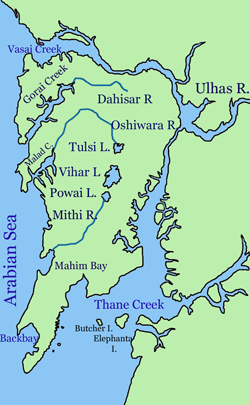Geography of Mumbai
This article needs additional citations for verification. (December 2009) |




Mumbai (Bombay) is India's most populous city with a population of 20 Million. It is located on Salsette Island off the coast of Maharashtra. The original Seven Islands of Bombay were merged by the British in the 18th century, to form one large island.
Hills
The original Seven Islands of Mumbai consisted of 22 hills. Most of them were razed to fill in the shallows to connect the islands. The hills still standing today are:
- Malabar Hill — the highest point in the city
- Cumbala Hill
- Antop Hill
- Sewri Hill
- Gilbert Hill
- Worli Hill
- Pali Hill
- Mazgaon Hill
- Sion Hill
- Mahakali Hill
- Golanji Hill
- Pulshachi Dongri
- Salamati Hill
- Kanheri Hill
There are three hill ranges with the city limits. The
The Powai Hills are present north of the city. The
Lakes
There are three lakes in the city. The Vihar Lake and the Tulsi Lake are present within the National Park and supply part of the city's drinking water. The Powai Lake is immediately south of these two. They are located in central Mumbai.
Bays
Mahim Bay is the second largest bay in the city. The Mithi River empties into the Mahim Creek which drains into the bay. The border between the city and its suburbs bisects the bay. To the north lies Bandra and to the south, Mahim.
Creeks
Mumbai has numerous creeks with close to 71 km2 of creeks and
Islands

Although the islands were merged in the 18th century, islands still dot Thane Creek. Elephanta Island, Butcher Island, Oyster Rock, Cross Island and Middle Ground are scattered across the Creek. The latter three are uninhabited islets owned by the Indian Navy.
Rivers
- Dahisar River
- Poisar River (Poisar-Poinsar River)
- Chandansar River
- Oshiwara River
- Vakola River
- Gadhi River
- Mahul River (Mahabali-Mahul River)
- Mithi River (Mahikavati-Mithi river)
References
- ^ Tatke, Sukhada (7 April 2012). "Mumbai for Me: Mangrove makeovers could save greenery". The Times of India. Retrieved 7 April 2012.
- doi:10.1890/130260.
